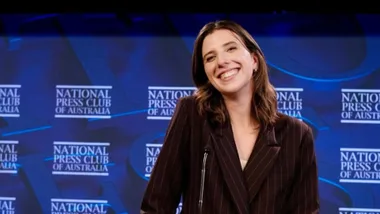Trigger warning: this article discusses sexual assault and violence and may be distressing to some readers.
In mid-January, the Australian government released a draft version of its 10-year national plan to end violence against women and children—a lengthy proposal years in the making with an ultimate goal of eliminating family and domestic violence entirely.
But already, the government is receiving backlash in its pre-rollout stages—a sign that for all its intents and purposes, there’s still a disconnect between the proposal itself and what it’s really going to take to begin the journey “towards zero”—in their own words.
After releasing the first draft for public consideration, advocates and experts across the nation called for the government to extend the consultation period beyond what it’s currently offering: two weeks.
Brittany Higgins, a former liberal staffer who sparked a national debate around workplace culture and harassment after she accused a former co-worker of raping her, voiced her disgust at the government’s fleeting timeframe for feedback on such an important plan.
“Breathtakingly disrespectful,” she penned. “The Govt have given community organisations and experts just TWO weeks to contribute to the upcoming 10-year Violence Against Women National Plan. Two weeks to map out the next 10 years of the fight against gendered violence in Australia.”
2021 Australian of the Year Grace Tame also weighed in, writing: “A perfect example of the Govt’s consistent approach to dire issues. I’m tired of being told we shouldn’t complain because “at least they’re making a plan”. Rubbish. Dig deeper and there’s nothing there. No genuine commitment, no legitimate action, just hollow words.”
It’s troubling that this plan, which is undoubtedly one of the most important and significant implementations this country will make in its response to gendered violence in the foreseeable future, is already showing cracks at such an early stage.
The timeframe for feedback remains at two weeks (ending on January 31), so if you want to have your say, you can provide feedback here. And below, find our detailed run-down on what the draft plan outlines.
What is the government’s national plan to end violence towards women and children between 2022-2033?
The current draft plan outlines a a two-pronged 10-year approach, broken up into two five-year action plans and two five-year Aboriginal and Torres Strait Islander action plans.
The current proposed national plan includes four “national pillars” to focus on.
- The first national pillar is prevention. Phrased by the government as “changing the story” in households, workplaces, schools, communities, institutions and social settings, this pillar is focussed on providing everyone with the tools to help stop violence before it starts by challenging views and attitudes.
- The second national pillar is intervention, which seeks to “change the trajectory” for individuals and families with higher-than-average risk of perpetrating or experiencing violence, or in situations where violence is starting to occur.
- The third and fourth national pillars are response and recovery, with an aim to ensure high quality and culturally appropriate response services, which can reduce the reoccurrence of violence and reduce its impact.
The national plan also includes four “foundation principals” which will aim to guide state and local governments, businesses, families, victim-survivors, the research sector, and communities in working together to address and prevent gendered violence. The four-pronged approach is:
- Addressing gender inequality.
- Drawing upon the diverse lived experiences of victim-survivors in order to inform and design appropriate and effective policies and solutions.
- Working alongside Aboriginal and Torres Strait Islander leaders, Elders and communities to end violence against Aboriginal and Torres Strait Islander women and girls.
- An intersectional and evidence-informed approach that considers the complexity and diversity of people’s lived experiences.
A major element of this plan that compares to former gendered violence plans laid out by the government is the focus on victim-survivors who can inform and improve the process in responding to gendered violence.
What happened in the last National Plan to Reduce Violence against Women and their Children 2010–2022?
Outlined in the new draft plan, the main achievements from the previous 10-year plan included “helping bring family, domestic and sexual violence to the nation’s attention, and [keeping] it in the spotlight” as well as “demonstrating the collective commitment to address family, domestic and sexual violence“—both of which are true in part. The increase in awareness and advocacy in this space is undeniable, however this has largely come from tragic, horrifying incidences of gendered violence which have triggered a national response in Australia.
For example, last year’s March 4 Justice came after Brittany Higgins made shocking allegations against a former liberal co-worker. Subsequently, advocacy movements, organisations and victim survivors themselves were compelled to act more and make their voices heard.
Brittany’s story is one of many that have received national attention, but we cannot solely rely on these brave women and people coming forward in order to trigger change—in order to create real change across Australia as a whole, we need better government intervention and support for these people, as well as a solid framework to prevent these acts of violence from occurring in the first place.
Thus, all the more pressure rides on this new national plan.
How will the national plan be implemented?
Per the draft plan, the government will implement a strategy which will “prevent” violence from the ground up. That means it will focus on education via programs in schools and workplaces which will teach both children and adults about consent, as well as empowering people to challenge behaviours that are disrespectful towards women and children.
This approach will trickle out into the community, with a hope to change attitudes that trivialise, normalise, excuse or downplay violence against women and children.
The government will monitor the plan’s progress by setting targets, as well as enlisting the Domestic, Family and Sexual Violence Commission, which was formed last year. The commission will monitor and report on the plan throughout its course. In 2033, it will publish a full evaluation on what it achieved.
If you are experiencing sexual abuse or other unwanted behaviour, please contact Full Stop Australia.










